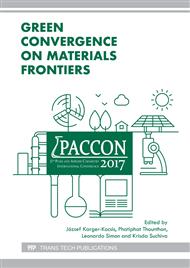p.125
p.131
p.141
p.146
p.151
p.156
p.161
p.166
p.171
Pyrolysis of Palm Oil in a Continuous Flow Microchannel Reactor
Abstract:
Palm oil is considered as a potential feedstock for biofuel production in Thailand due to its property and availability. In recent years, there has been an increased attention on upgrading of palm oil to biofuels using various technologies. One of the most promising technologies is pyrolysis, in which palm oil is heated at the temperature in the range of 400 to 500 °C under oxygen-free atmosphere. In the present study, the uncoated catalyst and coated catalyst pyrolysis processes of palm oil for biofuel production in a continuous flow microchannel reactor were investigated with various catalyst types (MgO, Al2O3) at 400-500 °C, 2 ml/hr palm oil flow rate, and 0.1 g of catalysts. Liquid product yield, solid product yield and gaseous product yield were determined. The obtained results revealed that the high triglyceride conversion could be achieved at a short reaction time in microchannel reactor, which attributed to the enhancement of both heat and mass transfer. The pyrolysis liquid products composed of hydrocarbons, free fatty acids, and other oxygenated compounds which are the results of triglyceride cracking. Furthermore, product selectivity of palm oil pyrolysis depended on temperature and catalyst type.
Info:
Periodical:
Pages:
166-170
Citation:
Online since:
October 2017
Authors:
Keywords:
Price:
Сopyright:
© 2017 Trans Tech Publications Ltd. All Rights Reserved
Share:
Citation:


